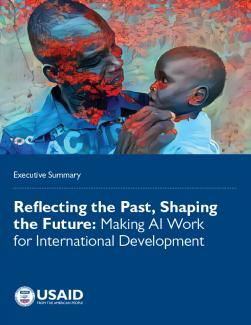THE PURPOSE OF THIS DOCUMENT
AI technologies are gaining prominence across the developing world and, if implemented carefully, can expedite a country’s journey to self-reliance. USAID’s 2018 report Reflecting the Past, Shaping the Future: Making AI Work for International Development outlines the promise of Machine Learning (ML) and Artificial Intelligence (AI) and gives reasons for caution as we engage with and integrate AI-based systems into development programming. This document summarizes the main findings of the report: setting the context, providing examples of ML and AI applications in development, laying out best practices for working with these technologies, and reinforcing the critical role of development practitioners in ensuring responsible deployment of these tools.
WHAT ARE ARTIFICIAL INTELLIGENCE AND MACHINE LEARNING?
Machine learning (ML) is a technique in which computers “learn” to recognize patterns in data, creating systems that can be more flexible, responsive, and adaptable than previously possible. Machine Learning is one component of Artificial Intelligence, just as learning is one component of human intelligence. Artificial Intelligence (AI) enables computers to automatically make decisions, often based on machine learning approaches. All ML/AI systems are built on data, which can come in many forms, including numerical, text, images and audio.
ML and AI applications may sometimes seem like science fiction, but these tools have become part of daily life for billions of people. Widespread digital services such as interactive maps, tailored advertisements and voice-activated personal assistants are likely only the beginning. Some AI advocates even claim that the impact of AI will be as profound as electricity or fire — that it will revolutionize nearly every field of human activity.

